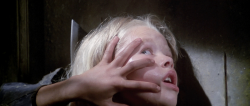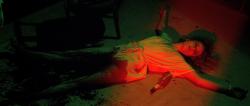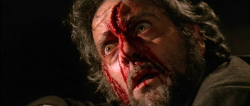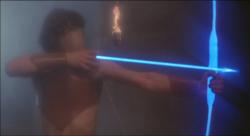Reviews
Lo squartatore di New York
Lucio Fulci
Italy, 1982
Credits
Review by David Carter
Posted on 08 January 2012
Source Blue Underground BRD
Categories Lucio Fulci’s Gates of Hell
The rise of VHS in the early eighties ushered in a moral panic over graphic cinema in Great Britain, culminating in the Video Recordings Act of 1984—more commonly known as the “video nasties” list. Italian horror cinema makes up the bulk of the list, including the now revered filmmakers Mario Bava and Dario Argento, and genre stalwarts that have yet to receive a similar critical reevaluation such as Joe D’Amato, Bruno Mattei, and Ruggero Deodato. Lucio Fulci has the dubious distinction of having the most films on the list with three: Zombi 2, The Beyond, and The House by the Cemetery. Noticeable by its absence is Fulci’s 1982 hyper-violent giallo The New York Ripper. Its omission shouldn’t be mistaken as evidence that the film was passed by the BBFC. On the contrary, The New York Ripper was banned outright when the theatrical prints arrived in Great Britain, where it was deemed so repugnant that all copies of the film were impounded and given a police escort out of the country.
What prompted such a highly publicized deportation for The New York Ripper? From a stylistic standpoint, the film bears a close resemblance to the majority of Italian gialli cinema and their American and British counterpart, the slasher film. Yet scores of such films were readily available and commercially successful in Britain and the world over, whereas The New York Ripper would be heavily censored if released at all. While less shockingly gory than his previous films, Fulci imbued The New York Ripper with an intangible quality that makes it difficult to watch even when compared to the more bloody entries in his oeuvre. The film is permeated with a contagion, a certain kind of nastiness, one which makes the viewer feel if somehow he or she is responsible for or even participating in the violence on screen. That feeling was exactly Fulci’s intent, and the fact that it is so effective is one of the greatest testaments to his brilliance as a director.
At its most basic level, the plot of The New York Ripper is archetypal giallo. An unseen killer is brutally murdering New York City prostitutes, only with a now-infamous innovation on the giallo formula: the killer’s bizarre signature is a Donald Duck voice and frequent quacking noises. A hardened, world-weary detective, Williams, is tasked with catching the murderer—dubbed “the New York Ripper” in the press because of the similarities between the crimes and those of Jack the Ripper. Psychiatrist Paul Davis assists Williams in the hunt, deducing that they are looking for a violent misogynist who is also intelligent enough to evade capture. The case becomes personal for Williams when his prostitute girlfriend, Kitty, becomes the Ripper’s latest victim, but he and Davis are forced to sift through a number of false leads before the killer is found.
The New York Ripper’s incredibly realized scenes of violence were primarily responsible for the ire the film drew upon its release. Though not necessarily more violent than Fulci’s other films of the period, the violence is not couched in the realm of the fantastic. From its first murder on the ferry, Fulci establishes the hyper-realistic tone of the film. Instead of presenting the murder as a beautiful set piece in the style of an Argento film, he makes it impossible to remain detached from what is occurring: the victim struggles futilely to escape and the killer’s blows are utilitarian, designed to create the most damage, not the most impressive display of gore. The film’s other murders, save the final one, are even more restrained and Fulci has managed to create a film far more terrifying than his earlier work while being less reliant on gore set pieces.
The New York Ripper is at its most distinctive in the aforementioned participatory nature of the work. Fulci has made a film where it is possible for the viewer to become fully engaged in every aspect of the story—we become simultaneously killer, detective, and victim while watching. He achieves this in part through his focus on eyes and vision - a Fulci trademark - both through the use of subjective point of view shots and through the primacy of eyes in the mise-en-scene. In a departure for the horror genre, the subjective point of view is not exclusively used to denote the presence of the killer. Fulci positions the audience as an unseen and unacknowledged presence throughout—our status as voyeur reinforced as we obsessively follow victims, police, and the suspects. This, perhaps more than any other factor, contributes the unsettling quality of the work as Fulci has effectively eliminated the distance between the viewer and the viewed, removing our ability to be unaffected by the horrors onscreen.
One of The New York Ripper’s most challenging aspects is the amount of time it dedicates to one of the Ripper’s eventual victims, Jane Lodge. Jane’s story bears a passing resemblance to elements of De Palma’s Dressed to Kill and is a narrative exploration of the visual motif of voyeurism that Fulci employs. Lodge is in an open relationship with her husband, an arrangement which is presented as her idea but one with which she is not entirely comfortable. Jane is the audience’s cipher as she enters the sexual underground of New York, a place where both the character’s assumptions and horror logic would dictate she will eventually cross paths with the Ripper. We are first introduced to Jane as she watches a live-sex show, after which one of the participants becomes the Ripper’s next victim. Our next encounter with her is during a moment of boldness: she has gone to a bar in order to pick up a partner, but her attempt at flirting ends in her nearly being assaulted. Jane evolves from voyeur to reluctant participant in a dangerous game, and we begin to see that Fulci is metaphorically exploring the relationship between the audience and his film. Reinforcing this idea that Fulci intends his viewers to be a participant in The New York Ripper, Jane’s arc is evidence that it is impossible to remain a voyeur—you eventually become a part of action, even if it is against your will. Fulci is functioning as his own critic in this regard. By intimating that one cannot simply observe his graphic horrors without accepting some measure of guilt, he’s essentially condemning himself and his audience. The fact that Jane eventually becomes a Ripper victim paints a picture that is incredibly bleak, but one that is undeniably in keeping with Fulci’s oeuvre.
The New York Ripper has been accused of being misogynist; a claim that Fulci perhaps anticipated. The film establishes that the murders are in no way sexual throughout, with the police’s focus on a sexual deviant being the misstep that allows the killer to evade capture. Any sexualization of the violence in the film is supplied by the viewer, not Fulci, and it would be a mistake to assume that images in The New York Ripper are sexual on the basis that similar images in other films have been. The film’s longest attack sequence, the attempted murder of Fay Majors, can in no way be interpreted as sexual, and the fact that is ultimately the film’s most important sequence reinforces the idea that the crimes are based on a psychosis, not sex. Unlike the standard for giallo or slasher films, our killer is a normal man whose crimes are not based out of hatred of women or some type of sexual thrill, but instead are committed by proxy for a young girl. The mild-mannered Peter assumes the guise of the duck-voiced Ripper out of the anguish he feels for his terminally ill young daughter, attacking those he feels are misusing the freedom that she will never have. Fulci in fact subverts the typical tropes of the genre by establishing some sort of sexual deviance for every character, including Williams and Davis, except for Peter.
All of Fulci’s films from this period conclude with an apocalypse of some type, either personal or global, and The New York Ripper is no different. It is possibly his most nihilistic; a surprise considering his recent works had ended with the destruction of world (in both Zombi 2 and The City of the Living Dead), the heroes trapped in hell (The Beyond), or with the main characters trapped in an endless cycle of horror (The House by the Cemetery). The New York Ripper ends with Peter’s daughter calling him, unaware of his death. When he doesn’t answer, she breaks down at the thought the only person in her life has abandoned her. Her cries are eventually drowned out by the noise of New York’s cars and people. As he does throughout the film, Fulci is again challenging the audience: which is worse, a killer or world that doesn’t care about a dying child? It’s a question that he offers no answer to, instead leaving it as a final uncomfortable blow to the viewer. Ultimately, The New York Ripper is unsettling not for what it makes you watch, but for what it makes you consider.
More Lucio Fulci’s Gates of Hell
-

City of the Living Dead
1980 -

The Beyond
1981 -

House by the Cemetery
1981 -

The New York Ripper
1982 -

Manhattan Baby
1982 -

Conquest
1983
We don’t do comments anymore, but you may contact us here or find us on Twitter or Facebook.



